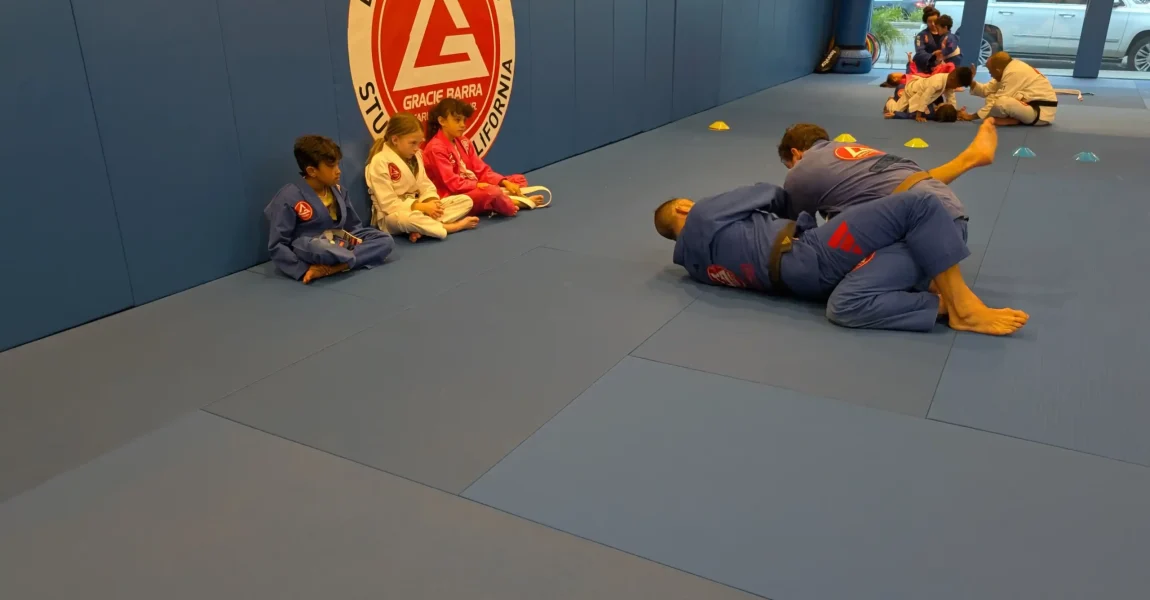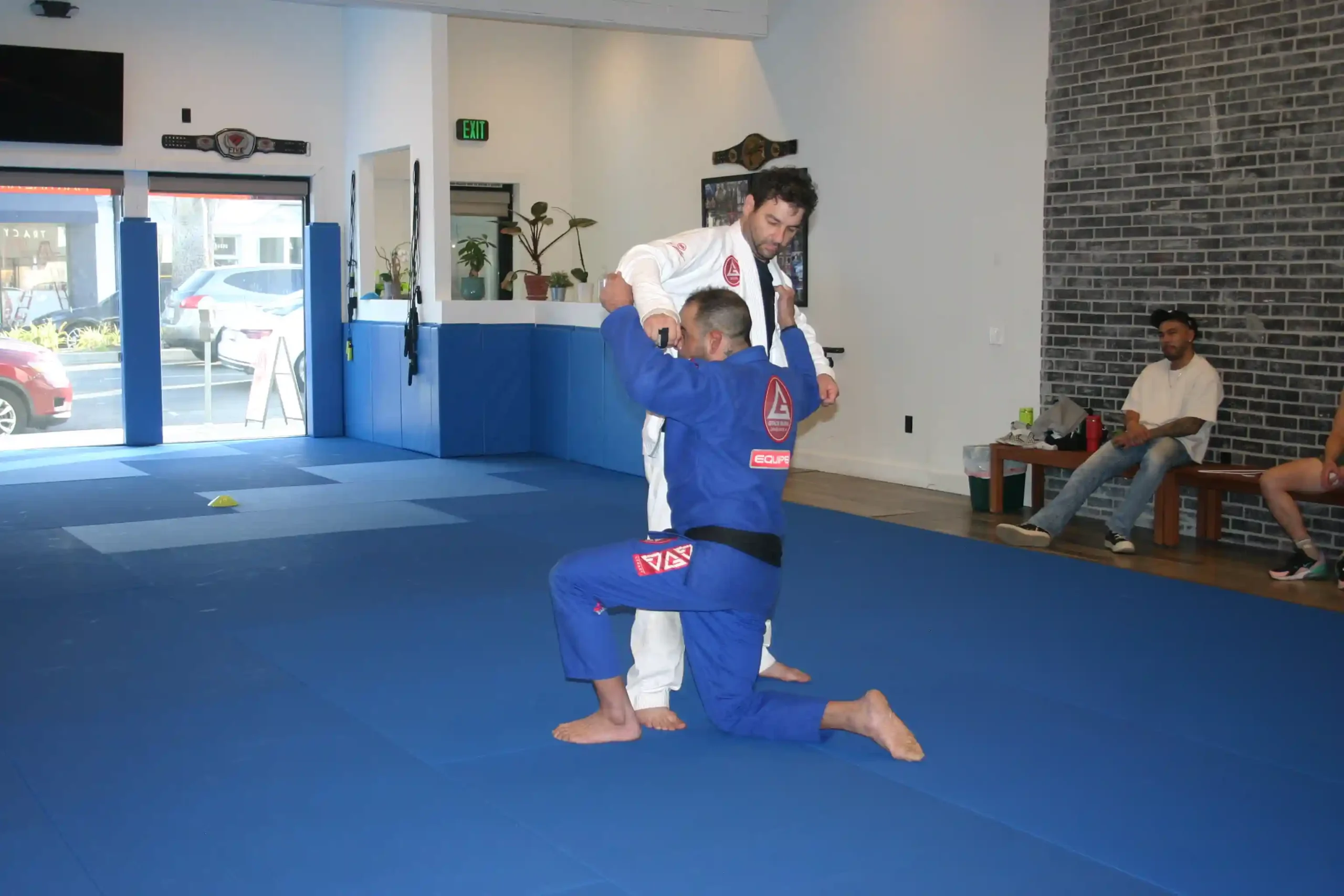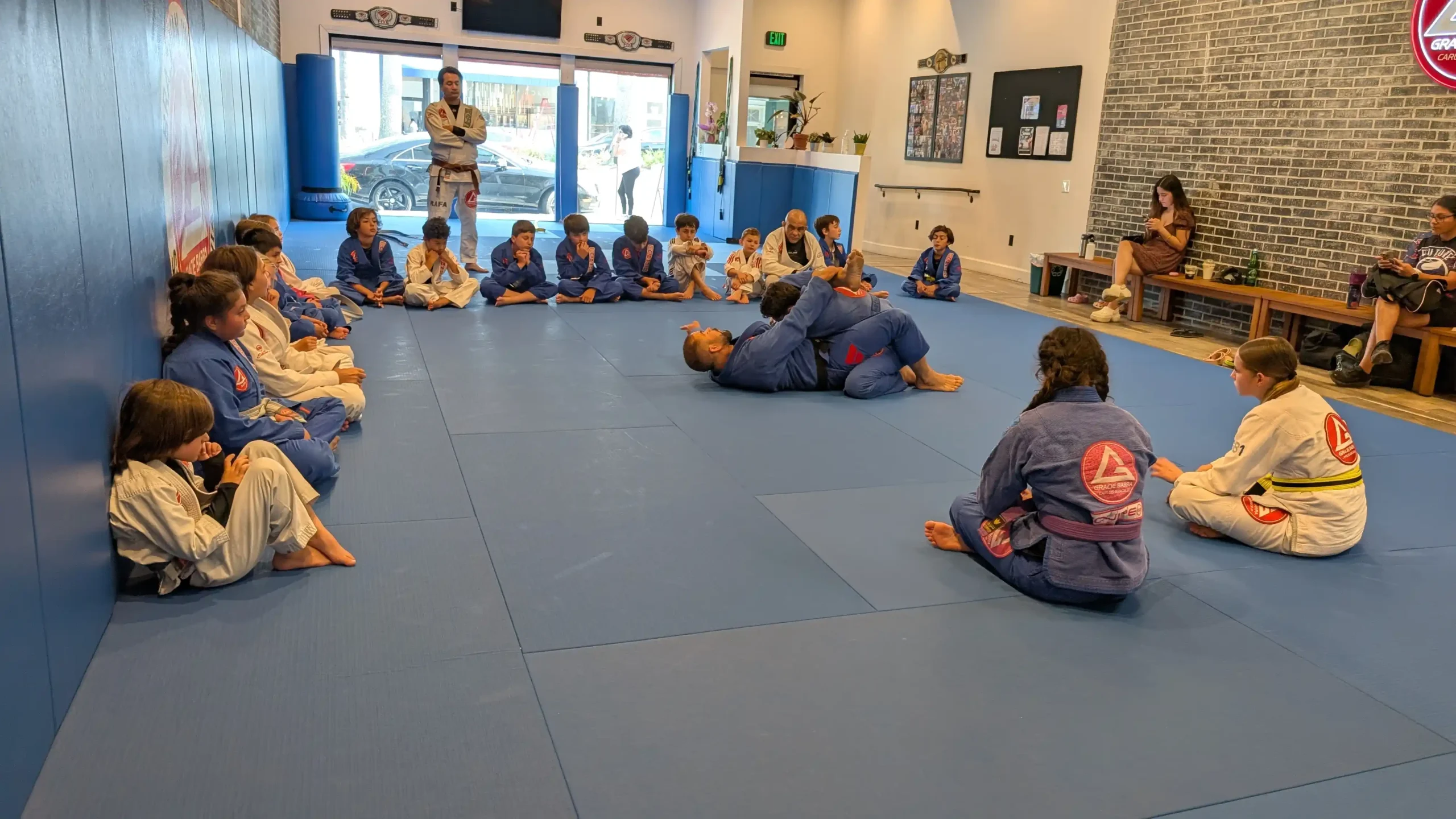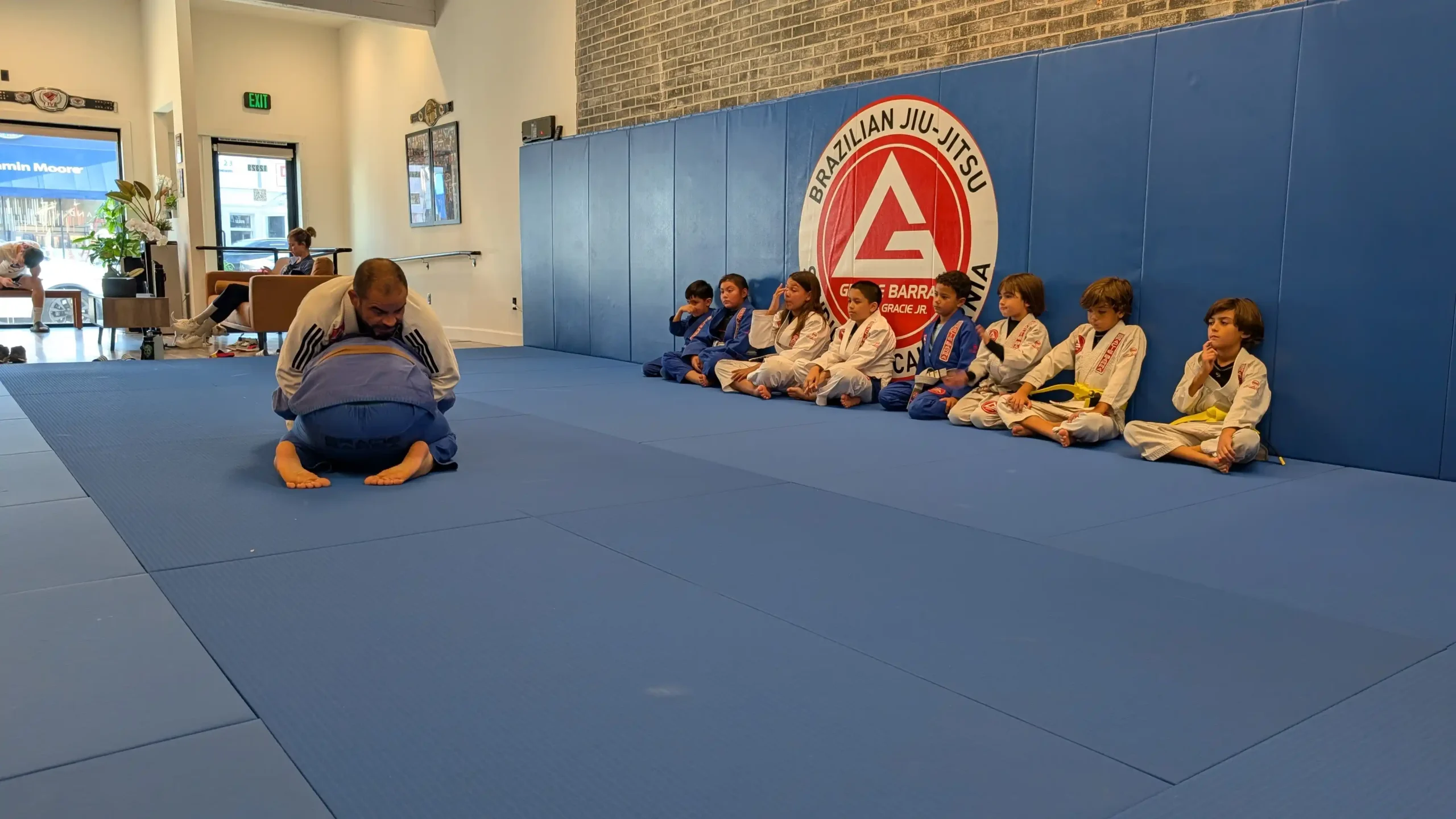“Position before submission” is the mantra in every BJJ class. But once you’ve secured that control, the next move is just as important: the submission.
These aren’t flashy moves meant to impress. They’re reliable techniques that hold up under real pressure and against resisting opponents. If you’re new to BJJ, start with simple submissions like the Americana, triangle choke, or ankle lock. These help you build confidence and strong basics. Whether you’re just beginning or already training, learning when and how to use the right submissions makes a big difference.
What Exactly Are Submissions in Brazilian Jiu-Jitsu?
Submissions in Brazilian jiu-jitsu are the reason why you win. You apply pressure to a joint or choke the opponent to signal a clear end to the match. But it’s not about hurting anyone; it’s about control. Technique over force. Timing over power. That’s why Brazilian Jiu-Jitsu Los Angeles schools like Gracie Barra Studio City continue to attract students from all backgrounds, whether for martial arts, self-defense, or MMA.
A well-timed submission tells a story: you outmanoeuvred, out-thought, and ultimately outlasted your opponent. It’s as much mental as it is physical.
Who This Guide Is For:-
Whether you’re just starting or fine-tuning your technique, this guide breaks down essential Brazilian jiu-jitsu submissions for beginners, competitors, and anyone looking to level up their ground game with reliable, high-percentage finishes.
- Beginners are just getting a grip (literally) on what’s out there.
- Intermediate students are ready to sharpen their finishing tools.
- Competitors who need high-percentage moves they can trust when it counts.
If you’re looking for clean, reliable jiu-jitsu submissions that will serve you in both gi and no-gi environments, here’s your foundation.
Transform Your Fitness Journey—Book a Free Trial Class!
Top 10 High-Percentage BJJ Submissions You Should Learn
These aren’t just trendy or flashy; they’re battle-tested. You’ll see them in local tournaments, world championships, and casual rolls every day.
1. Rear Naked Choke (RNC)
Used from: Back Control
The Rear Naked Choke is one of the most effective submissions in all of Brazilian Jiu-Jitsu. It works without the gi, relies on technique over strength, and ends matches fast. Once you regain control, the key is maintaining your position and setting the choke patiently. It’s clean, reliable, and tough to escape.
2. Armbar (from Guard or Mount)
Used from: Closed Guard, Mount, Side Control
3. Triangle Choke
Used from: Guard, Mount
The triangle choke is a powerful submission that uses your legs to trap your opponent’s neck and arm, cutting off blood flow and forcing the tap. It allows you to stay in a strong guard position while applying constant pressure. Proper leg positioning and posture control are key to making this choke truly effective.
4. Guillotine Choke
Used from: Standing, Guard, or Sprawl
The guillotine choke is a fast, versatile submission that’s perfect for catching opponents who shoot in with poor head placement. It’s especially effective in no-gi training and can be applied from multiple positions. The key is securing the neck and staying patient. Rushing the finish too early can give your opponent an easy escape.
5. Kimura Lock
Used from: Guard, Side Control, North-South, Mount
The Kimura is a versatile shoulder lock that works as both a powerful submission and a setup for sweeps or transitions. It allows you to break your opponent’s posture and control their upper body with a tight figure-four grip. Whether you finish it or use it to advance, the Kimura is a game-changer.
6. Americana Lock
Used from: Mount or Side Control
The Americana is a straightforward shoulder lock that’s ideal for beginners learning to control from dominant positions. It relies more on precision than speed, making it easy to apply with proper technique. By pinning the arm and isolating the shoulder joint, this submission becomes a reliable tool for finishing while maintaining positional dominance.
7. Ezekiel Choke
Used from: Mount or Side Control
The Ezekiel choke often catches people off guard, especially in gi classes. You use your sleeve to apply pressure across the neck while slipping in your second hand to tighten the choke. If timed right, it works quickly before your opponent sees it coming or can react.
8. Bow and Arrow Choke
Used from: Back Control (with Gi)
The bow and arrow choke is a dynamic gi submission that utilises collar grips to apply sharp, angled pressure to the neck, much like drawing a bowstring. It’s elegant but brutal, especially when paired with strong leg control. Once locked in, it’s one of the tightest and most difficult chokes to escape in BJJ.
9. Ankle Lock (Straight Foot Lock)
Used from: Leg Entanglements (Ashi Garami)
The straight ankle lock is a fundamental leg submission and a great introduction to lower-body attacks. It targets the Achilles tendon with focused pressure, making it effective even at beginner levels. Legal in most white and blue belt competitions, it teaches control, positioning, and restraint, key elements for safely exploring the leg lock game.
10. Omoplata
Used from: Guard
The omoplata is a creative shoulder lock that blends submission with positional advancement. It’s a bit more technical, often catching opponents off guard with its unorthodox angle. Flexibility helps, but the real key is controlling posture and staying heavy on the shoulder. If the finish isn’t there, it still offers a smooth sweep opportunity.
How to Train These Submissions Effectively
Learning the move is one thing. Executing it under resistance is a different challenge entirely
1. Drill Consistently
2. Focus on Timing
It’s not just about knowing the move; it’s about knowing when to apply it. Well-timed submissions catch opponents off guard and succeed more often than ones forced too early or in the wrong position.
3. Train Against Resistance
Light rolling or positional sparring helps bridge the gap between drilling and real application. Testing your submissions under pressure builds confidence, sharpens instincts, and teaches you to adapt when your first attempt doesn’t work.
4. Respect Leg Locks
Leg locks are powerful tools, but require precision and control. BJJ Beginners should learn them with guidance and follow the gym rules carefully. Rushing can lead to injury, but practised properly, it adds real depth to your game.
Step Onto the Mat and Start Your BJJ Adventure!
Conclusion
These ten moves are your ground game foundation: versatile, reliable, and built to grow with you and help you stay sharp when the adrenaline hits and the match heats up. Each Brazilian Jiu Jitsu submission on this list works in both gi and no-gi settings, and they’ll serve you from white belt to black.
Take your time, focus on a few moves, and practice them. Make mistakes, learn, and keep improving.
Want to Learn These Submissions Firsthand?
Gracie Barra Academy in Studio City is more than just a gym; it’s a Brazilian Jiu-Jitsu school that offers structured classes for beginners through advanced levels. Whether you’re in Glendale, North Hollywood, or right here in Studio City, you’re welcome to join a session and learn from experienced instructors who specialise in helping students at every stage of their BJJ journey.
Frequently Asked Questions
The Americana and straight ankle lock are great for beginners. They’re simple to learn, don’t require fancy setups, and you’ll see them come up a lot in class, just two of many you’ll find when starting with basic jiu-jitsu submissions or exploring all submissions in BJJ.
The basics stay the same, but the grips change. In gi, you can use the uniform for chokes and control. No-gi relies more on body grips and speed.
Either one is a great starting point. Gi helps you build control and patience, while no-gi sharpens your speed and timing. Most students try both over time.
Everyone’s pace is different, but if you train consistently, you’ll start hitting clean submissions in sparring within 3 to 6 months.
Yes, as long as they’re taught properly and trained with care. Always follow your academy’s rules and tap early if you’re unsure.




